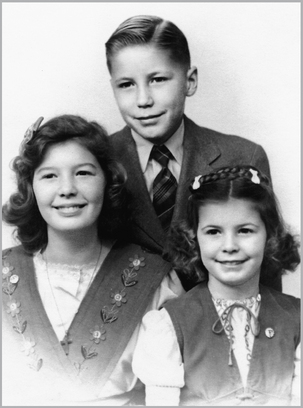
Robert Ames, age eleven, with his sisters Patricia (left), age fourteen, and Nancy (right), age eight. They grew up in a working-class Philadelphia neighborhood. Their father, Albert, was a steelworker and their mother, Helen, was the homemaker—and the disciplinarian.
Courtesy of Nancy Ames Hanlon

Bob Ames, age nineteen, worked his summers as a lifeguard on the Jersey Shore. He earned a four-year athletic scholarship at La Salle University, where his basketball team, the Explorers, won the NCAA 1954 national championship. Ames would shoot baskets for the rest of his life.
Courtesy of Yvonne Ames
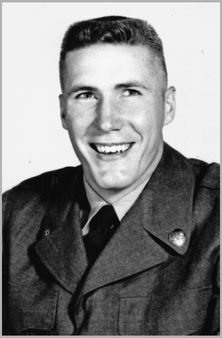
In 1957, Private Robert C. Ames was stationed at Kagnew Station, Ethiopia, where the U.S. Army ran a “listening post” to intercept radio signals from around the world. While at Kagnew, Ames began to teach himself Arabic. Courtesy of Yvonne Ames

The Ames clan, December 1959. Left to right: Nancy Ames Hanlon, Albert C. Ames, Grandma Amorose, Helen Amorose Ames, Bob Ames, and Yvonne Blakely.
Courtesy of Nancy Ames Hanlon

In 1959, Ames met Yvonne Blakely, the daughter of a U.S. Navy commander. She was a “Gibbs girl” secretary and he was then working as a repo man for All State Insurance Co. They wed in 1960, and that summer he interviewed for a job at the CIA.
Courtesy of Nancy Ames Hanlon
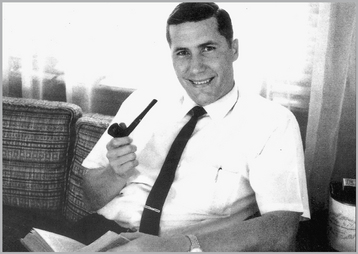
In 1962, the CIA posted Ames and his family to Dhahran, Saudi Arabia, where his assignment included collecting intelligence on radical Arab nationalists opposed to the Saudi monarchy.
Courtesy of Nancy Ames Hanlon
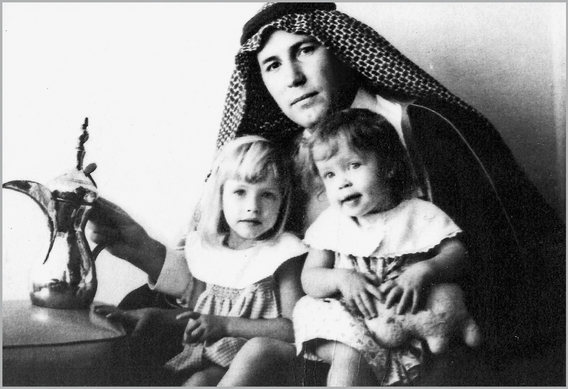
Bob Ames in Saudi Arabia, Christmas 1964, with his daughters Catherine and Adrienne. Ames was becoming fluent in Arabic. “He was one of the best spooks I ever met,” recalled a colleague.
Courtesy of Nancy Ames Hanlon

The CIA sent Ames to Aden in South Yemen in 1967. It was a war zone. “Everywhere you look there are soldiers with guns,” Bob wrote home. “Kind of creepy.” But he grew to love Yemen’s backcountry: “I got some frankincense which I’ll send home some day, hopefully by Christmas.”
Courtesy of Yvonne Ames
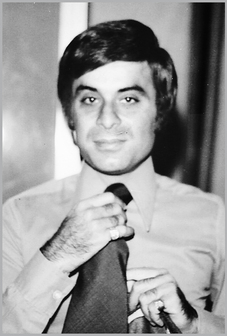
In 1969, Ames met Mustafa Zein, a young Lebanese businessman. Zein was an Arab Zelig—he seemed to be everywhere and to know everyone in Beirut. Ames nicknamed him the Catalyst, and Zein called Ames the Munir—Arabic for “enlightener.”
Courtesy of Mustafa Zein
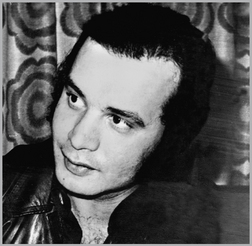
Ali Hassan Salameh, age twenty-seven, was Yasir Arafat’s PLO security chief in 1969 when his friend Mustafa Zein arranged a clandestine meeting with Bob Ames in Beirut’s Strand Café. “Ali looked at Bob, and then pointed to me,” Zein recalled, “and said, ‘This is my man.’ ”
As-Safir newspaper, Beirut
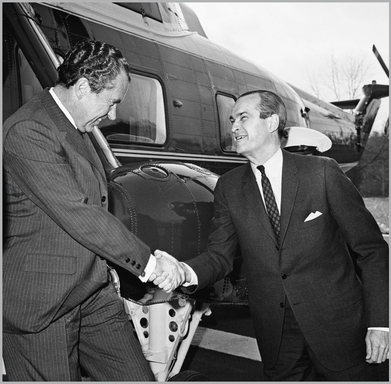
CIA director Richard Helms (right) greeting President Richard Nixon in 1969. Helms was Bob Ames’s mentor inside the CIA. Helms encouraged Ames to develop his clandestine relationship with Ali Hassan Salameh—even though the Nixon Administration and Henry Kissinger had banned any contact with the Palestine Liberation Organization. Corbis Bettmann
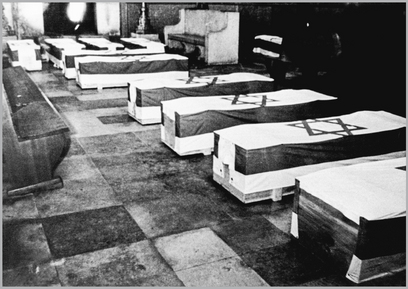
Caskets of the eleven Israeli athletes murdered at the September 1972 Munich Olympics by a team of Black September terrorists. “After that act no one would listen anymore,” Ames wrote. “All sympathy was gone. The only thought was that this should never happen again.” Corbis Bettmann
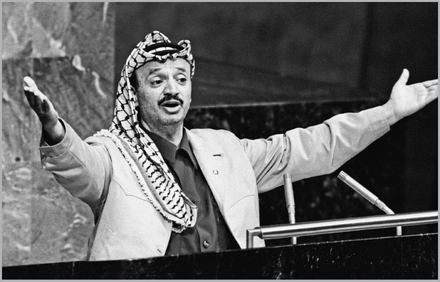
The PLO’s Yasir Arafat addressed the United Nations on November 13, 1974. Ames played a key role in getting Arafat and Ali Hassan Salameh to New York. “I’m just a middle man in all this,” Ames wrote. They stayed at the Waldorf Astoria—and before leaving, Salameh bought a postcard of the famous hotel and wrote to his son, “The PLO at the Waldorf Astoria!” Corbis Bettmann
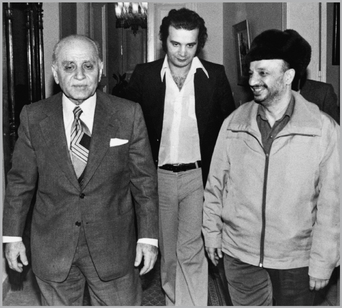
Former Lebanese prime minister Saeb Salam (left) with Ali Hassan Salameh and Yasir Arafat (right) in 1976. Ames assigned Salameh the CIA cryptonym MJTRUST/2. By 1976, Salameh’s fedayeen from Force 17 were providing security for the U.S. embassy in the midst of the Lebanese civil war.
As-Safir newspaper, Beirut

Ali Hassan Salameh shaking hands with Pierre Gemayel, a Lebanese power broker and founder of the right-wing Phalangist Party. His son Bashir Gemayel (center), a Maronite Christian warlord, was elected president in 1982—but was assassinated within weeks. As-Safir newspaper, Beirut
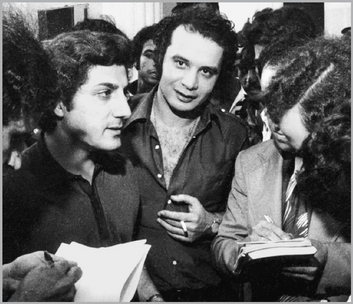
Bashir Gemayel (left) and Ali Hassan Salameh were enemies who admired each other. Ames called Bashir “our brutal warlord.” As-Safir newspaper, Beirut
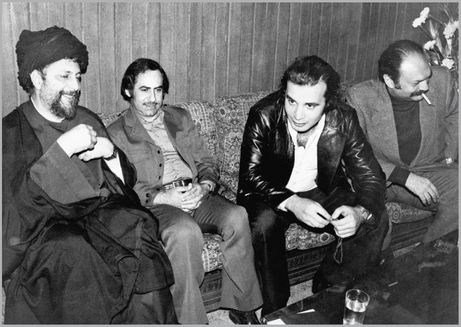
The Imam Musa Sadr (far left) with Ali Hassan Salameh (right, wearing a leather jacket) in 1975. Musa Sadr, the spiritual leader of Lebanon’s Shi’a Muslims, vanished mysteriously in 1978 on a trip to Libya. Ames asked Salameh to investigate the Imam’s disappearance. As-Safir newspaper, Beirut
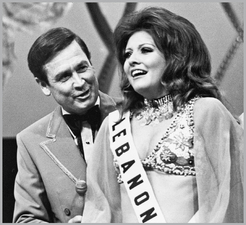
Georgina Rizk with Bob Barker in Miami Beach upon being selected Miss Universe of 1971. “She is Lebanon’s queen, Lebanon’s goddess.” Ali Hassan Salameh began dating Rizk in 1976, and that year Ames arranged for the couple to visit Washington, D.C.; Disneyland in Anaheim, California; and Hawaii. Associated Press
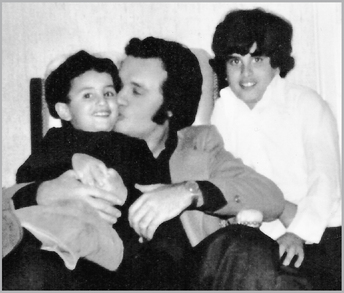
Ali Hassan Salameh with his two boys by his first marriage, to Nashrawan Sharif. Ames frequently visited Salameh at his home with wife Nashrawan, and he frowned on Salameh’s affair with Georgina Rizk: “This affair is ruining his reputation.” Salameh nevertheless married Rizk in June 1977.
Courtesy of Mustafa Zein
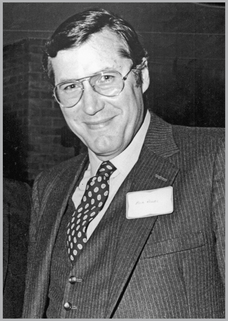
In the autumn of 1978 Ames was promoted to National Intelligence Officer for the Near East and South Asia. It was a big step up and a step away from clandestine operations. “Bob had a reputation in the DO [Directorate of Operations] of being too smart, too much of an intellectual.” Courtesy of Yvonne Ames

In November 1978 Ames flew to Beirut to warn Salameh that Mossad was once again targeting him for assassination. “I know that I’ll die,” Salameh said fatalistically. On January 22, 1979, his convoy passed a Volkswagen packed with explosives. When it blew up, Salameh was killed together with eight other people. As-Safir newspaper, Beirut
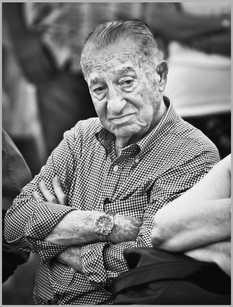
Mike Harari, the head of Mossad’s Caesarea clandestine unit in the 1970s, tried to assassinate Ali Hassan Salameh in Norway in 1973, but his team mistakenly killed an innocent Moroccan immigrant. Harari succeeded in 1979. Mossad officer Erika Chambers pushed the remote-control button that ignited the explosives just as Salameh’s car passed her balcony. Haaretz newspaper / credit: Dudu Bachar
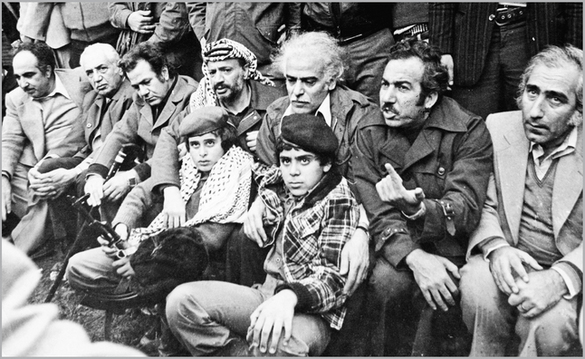
Yasir Arafat (center with keffiyeh headdress) at Ali Hassan Salameh’s funeral. His arm is draped across Ali’s son Hassan, who is holding an AK-47 Kalashnikov gun in his hand. As-Safir newspaper, Beirut
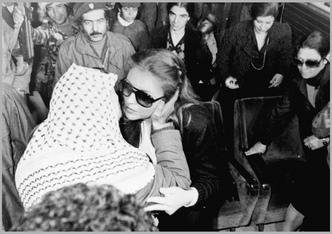
Yasir Arafat kissing a pregnant Georgina Rizk, one of Ali Hassan Salameh’s two widows. “The day Ali Hassan Salameh was killed was a very bad day,” recalled one of Ames’s colleagues.… “Bob was clearly stunned when he heard the news.” As-Safir newspaper, Beirut

Dewey Clarridge (left), George Cave (center), and Alan Wolfe (right). All three senior clandestine officers worked closely with Ames.
Courtesy of Henry Miller-Jones

William Casey brought to the CIA a fiery Catholicism and Cold Warrior certitudes. Courtesy of Corbis Bettmann
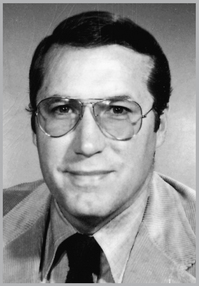
Ames (wearing his trademark tinted aviator glasses) enthralled Casey with his spycraft stories. Casey promoted him to become the CIA’s chief analyst for the Middle East. Courtesy of Yvonne Ames

Paul Wolfowitz (left), President Ronald Reagan, and Ames (second from right) at Camp David. Ames regularly briefed Reagan about the Israeli invasion of Lebanon in the summer of 1982. “It is a tricky business,” recalled one of Ames’s colleagues. “Do you try to stay true to your views or do you try to remain effective? At some point, people stop listening to you.” Courtesy of Ronald Reagan Presidential Library
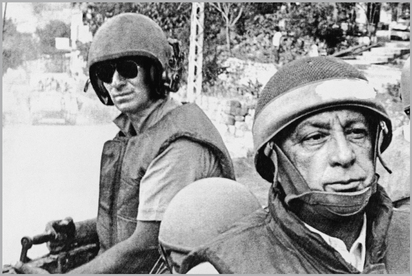
Israeli Defense Minister Ariel Sharon (right) with his troops in Lebanon. When asked how far he intended to advance into Lebanon, Sharon replied, “As far as we have to.”
Corbis Bettmann

After Arafat and the PLO were expelled from Lebanon, Phalangist militiamen massacred more than 1,000 Palestinian and Shi’ite Lebanese refugees in Sabra and Shatila. Ames was then working closely with Secretary of State George Shultz, who said, “The brutal fact is we are partially responsible.” Corbis Bettmann

Janet Lee Stevens, age thirty-two, was an American reporter who was known in the Sabra and Shatila refugee camps as “the Little Drummer Girl.” She served as John le Carré’s guide in the camps and spent the rest of her life investigating the massacre. Courtesy of Kristen Stevens

At 1:04 P.M. on April 18, 1983, a truck bomb destroyed the U.S. embassy in Beirut. “The smoke had cleared, but blood and body parts were everywhere. It is a smell you never forget.” Corbis Bettmann / credit: Claude Salhani
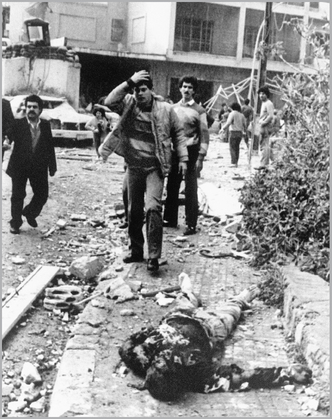
Sixty-three people died, including seventeen Americans and thirty-two Lebanese embassy employees. Eight of the Americans were CIA officers.
Getty Images
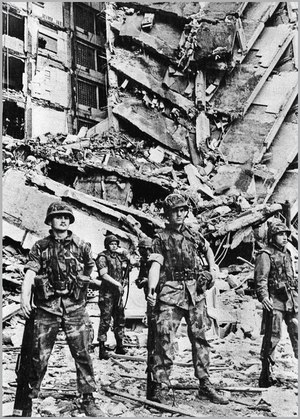
U.S. Marines form a perimeter around the destroyed U.S. embassy. “Bob Ames among the dead in Beirut,” wrote a White House official in his diary. “We believe Iran involved. Felt very sad about Bob.”
Getty Images

President Reagan and Nancy Reagan walk by sixteen caskets at Andrews Air Force Base. “Nancy and I met individually with the families of the deceased,” the president noted in his diary. “We were both in tears—I know all I could do was grip their hands—I was too choked up to speak.” Ames was the only victim Reagan had known personally. Courtesy of Ronald Reagan Presidential Library
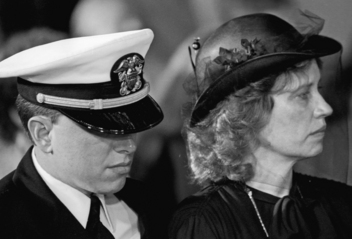
Yvonne Ames at Andrews Air Force Base, standing with her brother, a U.S. Navy officer. She was not told which casket contained Bob’s body. “Bob’s death fractured our family,” she later explained. “It’s like when you take a photograph and rip it. You can try to piece it back together, but it’s never the same.” Courtesy of Ronald Reagan Presidential Library

Imad Mughniyeh (left) with Hassan Nasrallah, secretary general of Hezbollah. Ali Hassan Salameh recruited Mughniyeh into Force 17 in the 1970s. But by 1983 Mughniyeh was working for the Iranians in Beirut—and he was thought to be involved in the U.S. embassy bombing: “When in doubt, and we are always in doubt about this, blame Mughniyeh.”
As-Safir newspaper, Beirut
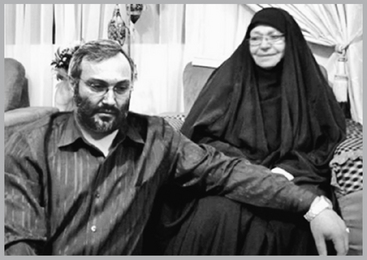
Imad Mughniyeh with his mother. He operated in the darkest of shadows. A former director general of the Mossad described Mughniyeh as “very shrewd, very talented … He was the liaison between Hezbollah and Iran.”
Courtesy of Al-Akhbar newspaper, Beirut

On February 12, 2008, Mughniyeh was assassinated in Damascus when the headrest in his booby-trapped Mitsubishi car exploded. “Mughniyeh was assassinated by the Israelis, with intelligence on his whereabouts furnished by the CIA.” Associated Press

General Ali Reza Asgari, an Iranian Revolutionary Guard intelligence officer who defected to the United States in 2007. According to Mustafa Zein, it was Asgari who recruited Mughniyeh and planned the 1983 truck bomb attack on the U.S. embassy. “At the unclassified level, I cannot elaborate on the issue,” said a U.S. intelligence official.
Corbis Bettmann
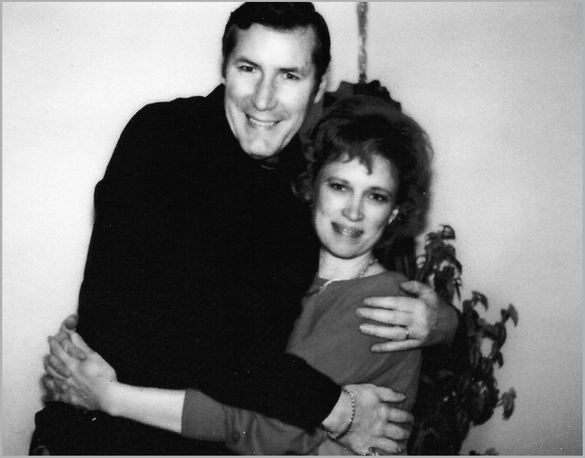
The last photograph of Bob and Yvonne, Christmas 1982. Courtesy of Yvonne Ames